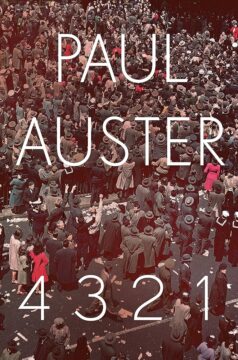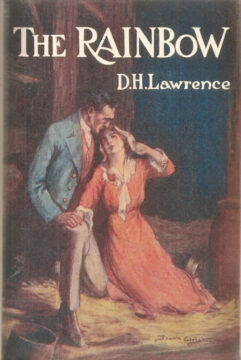To the Young Protestants holding Portraits of Martin Luther on
the steps of the Catholic Cemetery in Bielsko on All Souls Day
When Luther couldn’t convert his Jewish neighbors, he wrote:
Set fire to their synagogues and schools in honor of our Lord
and of Christendom, that God might see we are Christians.
Between us iron grates and the cries of blackbirds on graves.
Wind circles the firs. A child bounces a red ball.
You stand smiling after five hundred years. You ask for nothing
more than a coin from history, the blessing of pigeons nibbling
crumbs at your feet, but it was never this simple. How young
I was when my parents converted from Catholicism, entered
the plain nave of a Protestant chapel and its Bach cantatas.
Condemned by priests, shunned by our Irish relatives,
we became devout Presbyterians. My Polish grandfather,
a religious and political rebel, wouldn’t let a priest in his house.
In Sunday school, I was taught about the Reformation’s doctrines,
martyrs, exiles. What can a child understand of cruelty
and dogma? I missed my cousins in their First Communion
finery, their frosted cakes. In Europe, in Ireland, death came
for centuries with the swing of a censer, a bare cross replacing
the crucifix, families divided with the slice of a cake knife.
We stand in this land where the people of the book visit us
in the fall wind—Jews and Christians, who’ve strayed,
says the Quran, from God’s true faith. Enough, the blackbirds cry.
by Tersa Cader
from Plume Magazine

 Since the 19th century, large numbers of villagers in the poorer parts of Italy have migrated to more prosperous regions and countries. The migration continues; in some places, populations have shrunk so dramatically that there are no longer enough patients to keep the local doctor in business, or enough children to fill the school. Young people who moved away to study or work didn’t want to return, and when their parents died, the family homes stood empty, sometimes for decades. Around 2010, the village of Salemi in western Sicily was one of the first towns to come up with an idea: What if you could fill them again by offering the properties for sale at a ridiculously low price?
Since the 19th century, large numbers of villagers in the poorer parts of Italy have migrated to more prosperous regions and countries. The migration continues; in some places, populations have shrunk so dramatically that there are no longer enough patients to keep the local doctor in business, or enough children to fill the school. Young people who moved away to study or work didn’t want to return, and when their parents died, the family homes stood empty, sometimes for decades. Around 2010, the village of Salemi in western Sicily was one of the first towns to come up with an idea: What if you could fill them again by offering the properties for sale at a ridiculously low price? Vaccination led to the global eradication of smallpox in 1980. Even today, the Bill and Melinda Gates Foundation lists one of the goals of its malaria program as “ending malaria for good.” In recent years, Tufts University launched its
Vaccination led to the global eradication of smallpox in 1980. Even today, the Bill and Melinda Gates Foundation lists one of the goals of its malaria program as “ending malaria for good.” In recent years, Tufts University launched its YOU KNOW KEITH HARING. He drew breakdancers and mushroom clouds and triclops and dicks and death and he drew Warhol’s envy. He painted on the Berlin Wall and on Bill T. Jones and on Grace Jones. He painted CRACK IS WACK and SILENCE = DEATH. He smuggled SAMO into SVA to tag the school’s graffiti-blitzed stairwell. His chalk ikons perfused Ed Koch’s decrepit metro, scrawled on seemingly every empty ad space. They called him Chalkman and the Degas of the B-boys, they called him genius and sellout. Club 57, Danceteria, Area, the Roxy, the Pyramid, the Palladium, the Mudd Club, Paradise Garage. Uniqlo, Coach, Nike.
YOU KNOW KEITH HARING. He drew breakdancers and mushroom clouds and triclops and dicks and death and he drew Warhol’s envy. He painted on the Berlin Wall and on Bill T. Jones and on Grace Jones. He painted CRACK IS WACK and SILENCE = DEATH. He smuggled SAMO into SVA to tag the school’s graffiti-blitzed stairwell. His chalk ikons perfused Ed Koch’s decrepit metro, scrawled on seemingly every empty ad space. They called him Chalkman and the Degas of the B-boys, they called him genius and sellout. Club 57, Danceteria, Area, the Roxy, the Pyramid, the Palladium, the Mudd Club, Paradise Garage. Uniqlo, Coach, Nike. Indians tend to fetishize elections, which now wholly define their self-imagination as a democratic society, obscuring other institutional necessities. The
Indians tend to fetishize elections, which now wholly define their self-imagination as a democratic society, obscuring other institutional necessities. The  Lithuania has lost the Eurovision Song Contest thirty times. The first loss, in 1994, was awarded to Ovidijus Vysniauskas’ « Lopšinė mylimai » (Lullaby for my lover). The ballad about a secret love, worthy of a soundtrack to a Kevin Costner romance, received nul points and placed absolute last, disqualifying Lithuania from the next year’s contest and prophesying the three decades to come. (I count disqualification as a second loss rather than a continuation of the first loss. I also count withdrawals as losses.)
Lithuania has lost the Eurovision Song Contest thirty times. The first loss, in 1994, was awarded to Ovidijus Vysniauskas’ « Lopšinė mylimai » (Lullaby for my lover). The ballad about a secret love, worthy of a soundtrack to a Kevin Costner romance, received nul points and placed absolute last, disqualifying Lithuania from the next year’s contest and prophesying the three decades to come. (I count disqualification as a second loss rather than a continuation of the first loss. I also count withdrawals as losses.) Since 2000, the world has experienced
Since 2000, the world has experienced  Interstate 35 through Austin, Texas, is the most congested stretch of road in the fastest-growing city in one of the sprawliest states in the country.
Interstate 35 through Austin, Texas, is the most congested stretch of road in the fastest-growing city in one of the sprawliest states in the country. LAHIRI
LAHIRI T
T Auster spoke in a rolling purr that was equal parts seduction and lament. His voice sounded like cognac poured over stones instead of ice. In narrating 4321, he covered the whole range of human experience: birth, death, illness, sex, hope, failure, parents, children, revolution, and disillusion, all against the noisy backdrop of the midcentury American colossus. In an eerie parallel, one of the novel’s subplots deals with the student protests at Columbia University in 1968, which have been repeating themselves in a different context this spring. As a result of his constant presence, the topicality of his subject matter, I felt a keen pang of the false intimacy that sometimes strikes when celebrities die. I had listened to Auster speak for nearly the entire month of April. It is dreadful to know that his voice in all senses has been silenced. 4321 explores the life and times of a young man named Archie Ferguson born in 1947 to a Jewish family in Newark. The novel tells four diverging stories of a single individual in parallel chapters. The Archie described in chapters 1.1, 2.1, 3.1, and so on, is born into a stable family with loving parents who occupy traditional gender roles and harbor modest aspirations.
Auster spoke in a rolling purr that was equal parts seduction and lament. His voice sounded like cognac poured over stones instead of ice. In narrating 4321, he covered the whole range of human experience: birth, death, illness, sex, hope, failure, parents, children, revolution, and disillusion, all against the noisy backdrop of the midcentury American colossus. In an eerie parallel, one of the novel’s subplots deals with the student protests at Columbia University in 1968, which have been repeating themselves in a different context this spring. As a result of his constant presence, the topicality of his subject matter, I felt a keen pang of the false intimacy that sometimes strikes when celebrities die. I had listened to Auster speak for nearly the entire month of April. It is dreadful to know that his voice in all senses has been silenced. 4321 explores the life and times of a young man named Archie Ferguson born in 1947 to a Jewish family in Newark. The novel tells four diverging stories of a single individual in parallel chapters. The Archie described in chapters 1.1, 2.1, 3.1, and so on, is born into a stable family with loving parents who occupy traditional gender roles and harbor modest aspirations. Human spontaneity in Lawrence’s work—and indeed in his life as well—is not the simple, cheerful business that popular culture has often made it out to be. Think of those TV commercials in which an office worker suddenly does something unexpected, like dancing down the corridor of his office, to the comical dismay of his fellow workers. In Lawrence, spontaneity is dangerous and sometimes destructive, but it is necessary to being truly alive. The force of spontaneous love prompted Lawrence to run off with a married woman, Frieda Richthofen Weekley, and Frieda would regret leaving her three children for the rest of her life. Throughout their relationship, Lawrence and Frieda suffered continual eruptions of hostility that left them in pieces, but the marriage endured. It’s not uncommon to read in Lawrence’s biographies sentences like this: “The tension between Frieda and Lawrence abated after she struck him with an earthenware plate…” Lawrence would make creative use of this fight in Women and Love, when Hermione strikes Birkin with a paperweight, “almost breaking his neck, and shattering his heart.”
Human spontaneity in Lawrence’s work—and indeed in his life as well—is not the simple, cheerful business that popular culture has often made it out to be. Think of those TV commercials in which an office worker suddenly does something unexpected, like dancing down the corridor of his office, to the comical dismay of his fellow workers. In Lawrence, spontaneity is dangerous and sometimes destructive, but it is necessary to being truly alive. The force of spontaneous love prompted Lawrence to run off with a married woman, Frieda Richthofen Weekley, and Frieda would regret leaving her three children for the rest of her life. Throughout their relationship, Lawrence and Frieda suffered continual eruptions of hostility that left them in pieces, but the marriage endured. It’s not uncommon to read in Lawrence’s biographies sentences like this: “The tension between Frieda and Lawrence abated after she struck him with an earthenware plate…” Lawrence would make creative use of this fight in Women and Love, when Hermione strikes Birkin with a paperweight, “almost breaking his neck, and shattering his heart.” John Guillory is an award-winning teacher and scholar. His varied and influential work includes Poetic Authority: Spenser, Milton, and Literary History (Columbia University Press, 1983) and the field-transforming Cultural Capital: The Problem of Literary Canon Formation (University of Chicago Press, 1993). His brilliant new book, Professing Criticism: Essays on the Organization of Literary Study, argues that modern literary study remains anxious about the century-old professionalism that betrays the discipline’s relation to its amateur precursor, criticism. He discusses it here with John Plotz of Brandeis and Public Book’s coeditor in chief, Nicholas Dames. Dames is author of such prize-winning books as Amnesiac Selves (Oxford University Press, 2001) and The Physiology of the Novel (Oxford University Press, 2007), and most recently The Chapter: A Segmented History from Antiquity to the Twenty-First Century (Princeton University Press, 2023).
John Guillory is an award-winning teacher and scholar. His varied and influential work includes Poetic Authority: Spenser, Milton, and Literary History (Columbia University Press, 1983) and the field-transforming Cultural Capital: The Problem of Literary Canon Formation (University of Chicago Press, 1993). His brilliant new book, Professing Criticism: Essays on the Organization of Literary Study, argues that modern literary study remains anxious about the century-old professionalism that betrays the discipline’s relation to its amateur precursor, criticism. He discusses it here with John Plotz of Brandeis and Public Book’s coeditor in chief, Nicholas Dames. Dames is author of such prize-winning books as Amnesiac Selves (Oxford University Press, 2001) and The Physiology of the Novel (Oxford University Press, 2007), and most recently The Chapter: A Segmented History from Antiquity to the Twenty-First Century (Princeton University Press, 2023). Every organism visible to the naked eye is a mass of genetically identical cells. Each of these multicellular creatures started as a single cell that divided countless times to produce its body. And while each cell contains the same genome, they express their DNA in a variety of ways, giving rise to specialized cells and tissues that perform different roles, such as skin, liver or immune cells. This complex multicellularity has evolved independently in at least five lineages: animals, land plants, brown algae, red algae and fungi.
Every organism visible to the naked eye is a mass of genetically identical cells. Each of these multicellular creatures started as a single cell that divided countless times to produce its body. And while each cell contains the same genome, they express their DNA in a variety of ways, giving rise to specialized cells and tissues that perform different roles, such as skin, liver or immune cells. This complex multicellularity has evolved independently in at least five lineages: animals, land plants, brown algae, red algae and fungi.